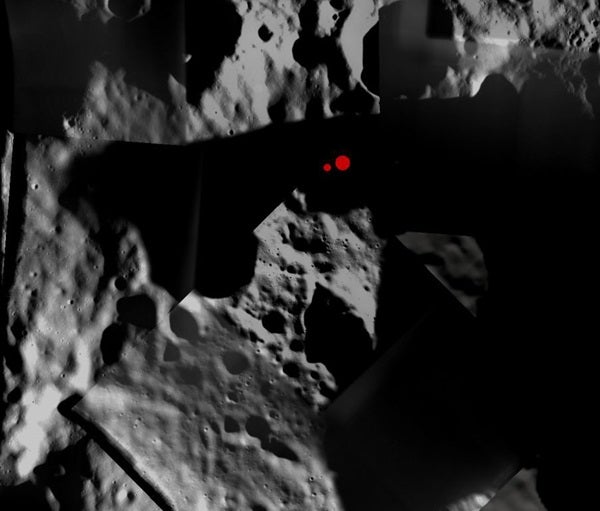The European Space Agency’s (ESA) Small Missions for Advanced Research in Technology (SMART-1) team has released an updated image of the future impact site of NASA’s Lunar Crater Observation and Sensing Satellite (LCROSS), after the LCROSS team announced a new target last week. LCROSS will search for water ice on the Moon by making two impacts into a crater named Cabeus at the lunar South Pole. The impacts are scheduled for October 9, 2009.
Bjoern Grieger, the liaison scientist for SMART-1’s AMIE camera, and Bernard Foing, ESA SMART-1 Project Scientist, have searched through SMART-1’s database for images of Cabeus, taken 4 years ago. The SMART-1 images are at high resolution as the spacecraft was near its closest distance of 310 miles (500 kilometers) from the South Pole. The SMART-1 images of LCROSS potential targets were discussed on September 18 at lunar sessions of European Planetary Science Congress (EPSC) in Potsdam, Germany.
The Cabeus crater interior is permanently shadowed, so ice lying inside the crater could be protected from the Sun’s harsh rays. LCROSS will send the upper stage Centaur rocket crashing into Cabeus and a shepherd spacecraft will fly into the plume of dust generated and measure its properties before making a second impact with the lunar surface. Astronomers will observe both impacts using ground and space-based telescopes. The SMART-1 spacecraft also concluded its mission with a controlled bouncing impact on September 3, 2006. The event was observed with ground-based telescopes (a “dry run” for LCROSS), and the flash from the impact was detected at infrared wavelengths.
“The Cabeus topographic features as observed by SMART-1 vary greatly during the lunar rotation and the yearly seasons due to the polar grazing illumination conditions,” said Foing. “The floor of Cabeus near LCROSS targets shows a number of small craters and seems old enough to have accumulated water ice delivered from comets and water-rich asteroids, and might have kept it frozen in its shadowed area.”
“These ESA SMART-1 observations of the Cabeus crater can help in the final planning and interpretation of LCROSS impact observations,” he said.










